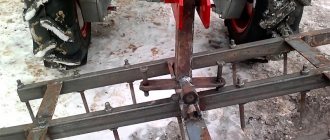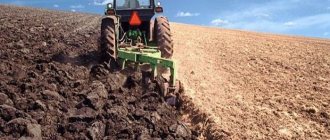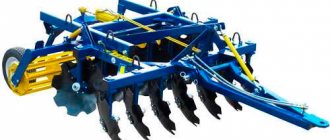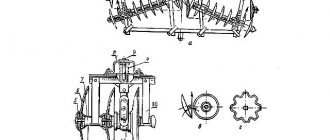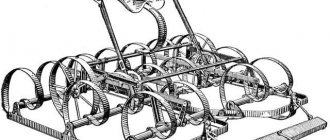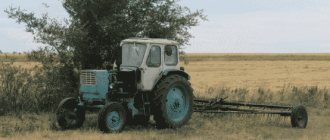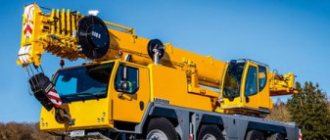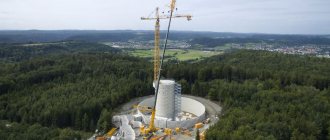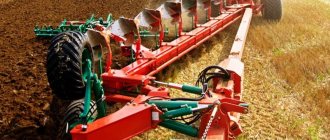Tilling the soil before planting crops is a very important event, on which the future harvest largely depends. In terms of time and physical effort, this work is perhaps the most labor-intensive and difficult. Modern manufacturing plants offer a wide range of mounted and trailed devices for walk-behind tractors and walk-behind tractors, designed for soil preparation. In this article we will look at devices such as harrows.
First of all, let's figure out how a harrow differs from a plow. The plow is designed for plowing the land with soil turnover. With this treatment, soil layers are mixed, weeds and pests are killed. The harrow carries out loosening, mixing, leveling the surface, destroying the soil crust and destroying fragile weeds without turning over the layers. With the help of a harrow, dense crops are thinned, soil and fertilizers are applied. Harrowing is carried out separately or in combination with plowing, cultivation, sowing and other operations.
In terms of design, three types of harrows have gained the most popularity: tine, disc and rotary (harrow-hoe).
Purpose, principle of operation
A harrow is an agricultural implement designed for soil cultivation (harrowing). By cultivating the soil with the help of this product, agricultural machine operators prevent the soil from drying out, level its surface, and also remove crust and weeds.
This implement can be used as a separate element and mounted on a tractor using a hitch. Or it can be used in conjunction with other equipment, such as cultivator legs: for example, together with plows or cultivators.
What is the principle of operation of this tool: when moving, the working sections, rotating, enter the soil and crush the soil layer along with weeds.
What is it for?
It is most appropriate to characterize this procedure using the example of early spring harrowing. There is a misconception among some farmers that this is an outdated procedure that is irrelevant in modern conditions. But in practice the situation is completely opposite. Early spring harrowing carried out with modern units provides a pronounced economic effect. The fact is that immediately after the snow cover melts, the soil becomes covered with a crust, which draws moisture from the lower layers.
That is why it is necessary to harrow the soil, destroying the formed capillaries and helping to maintain normal humidity. At the same time, the revival of weeds, various pests and pathogenic microorganisms remaining in the soil is prevented. Things are a little different with spring harrowing. As indicated in the name itself, it is also carried out in the spring, but at the same time they focus on achieving physical ripeness of the soil.
It is recommended to use harrows in areas occupied by winter crops as soon as possible.
And pre-emergence harrowing helps to effectively combat various weeds. Special literature notes that even this itself, without taking into account other measures, can eliminate up to 60% of weeds. The most suitable conditions for use are years with a cold, late spring. It is then that weeds that are more resistant to unfavorable conditions gain a strong advantage over cultivated plants. It is necessary to harrow the field before germination when:
- the land after sowing is not level enough;
- sowing had to be carried out in poorly heated soil;
- a pronounced earthen crust has formed;
- many weed seedlings appeared.
The following beneficial effects of harrowing are also noted:
- selective mixing and leveling of the outer soil layer;
- thinning of excessively thickened seedlings;
- increasing soil readiness for sowing;
- improving the condition of pastures;
- eliminating weeds and reducing soil density in clean and fallows.
Why do they harrow the soil?
There are many ways to cultivate the fertile layer of soil in your suburban area, regardless of whether it is a vegetable garden or a small field. However, each option for cultivating the soil must be timely; often different devices are used in a certain order, and it is not advisable to disrupt this order. This also applies to harrowing, which is performed several times a year. The first loosening of the soil - early spring harrowing - is carried out after the snow has completely melted and the soil has dried out a little.
Soil that is oversaturated with moisture cannot be loosened; it will cake and become denser. Dry soil is deprived of the water necessary for seedlings and is not crushed, breaking into large lumps. Fields with winter crops and grasses should be harrowed in early spring so that microbiological processes actively occur in the loose soil and oxygen reaches the plant roots. Pre-sowing cultivation of the land with a harrow (usually a disc harrow) pursues completely different goals.
The soil, broken into small lumps and leveled, allows the seeds to be distributed more evenly, so that seedlings will emerge simultaneously throughout the entire field. Often the harrowing process is combined with sowing, for which the loosening device is supplemented with a seeder. But pre-sowing tillage is not the last thing; the soil must be crushed even after the seeds have entered the fertile soil layer.
There are two options here: harrowing the soil before the shoots appear and loosening it after the shoots appear. One or another type of soil treatment can be carried out, or both sequentially, since the first is necessary to remove weed seedlings and crush the crust on the soil surface, and the second is only for weeding. We can also mention summer loosening, used for black fallow.
Disc harrow
The working elements of this type of tool are discs, which is how they got their name. They are located at a certain angle relative to the direction of movement - it is called the angle of attack. By changing it, you can vary the depth of the layer that needs to be processed. Discs for a disc harrow easily crush soil, loosen soil, and cut turf.
Products of this type are suitable for surface tillage of the soil before sowing. With their help, you can mix the top layer of soil, crush the roots of weeds, and restore the natural layer of humus.
How to properly cultivate the land
First, you should remove all unnecessary objects from the field. Then you should check the technique and the readiness of the teeth for work. Processing takes place at a fast pace. The average speed at which harrowing is 9-11 km per hour.
If foreign objects get into the harrow, it must be cleaned immediately. The most important factor influencing the quality of cultivated land is the timing of this procedure.
If you do the procedure too late, the soil will lose a lot of moisture. If you till the soil too early, the soil may become compacted.
Spring harrow
Spring harrows are used for cultivating soil after crops, as well as after harvesting them. The working body is a spring tooth, of different sections for each type of harrow. There are several types of such products: spring mounted harrow, semi-mounted harrow, trailed harrow.
The spring harrow on the cultivator does not harm crops. This tool also helps with fertilizing, collecting and felling straw.
Types of harrowing
There are different types of agricultural operations; depending on the situation and the goal, the farmer makes a choice in favor of a specific type of harrowing. Each method of leveling a planting area has both advantages and disadvantages. There are three methods of harrowing the soil: driven, figured and transversely diagonal.
Zagonnoe
The principle of this harrowing method is that with each passage of the territory, the harrows go beyond the edge of the field. If the cultivation of a plot of land is carried out in “two tracks”, then the first pass is made along, and the second – across the plowing line. In this case, on the plan the cultivated area looks like an elongated rectangle.
The main disadvantage of this method of harrowing a field is considered to be a large number of idle runs and irrational use of equipment resources and time.
Figured
With this method of processing the sown area, harrowing is carried out in a circle, which avoids empty runs and makes the most efficient use of the farmer’s technical resources and time. On the plan, the plot looks like a square, and the greater the similarity with this geometric shape, the higher the skill of the farmer who performs this agricultural operation. If the procedure is carried out in “two tracks”, then during the second pass the unit moves diagonally to the strip that was processed initially.
Transverse diagonal
Compared to previous harrowing methods, the cross-diagonal variety is considered the most effective. The “two-track” method of loosening the soil does not allow achieving maximum uniformity of tillage and completely leveling the field surface due to the fact that one path coincides with the direction of plowing. Even a very experienced farmer will not be able to achieve perfect leveling of the territory during figured or driven harrowing.
TOOLS AND MEANS OF MECHANIZATION FOR WORK IN AGRICULTURE AND CROPPING. Tillage implements
For soil cultivation, sets of implements include plows, cultivators, harrows, and cutters.
Individual samples of soil-cultivating tools are made by folk craftsmen. Plows. All walk-behind tractors and mini-tractors are equipped with single-body plowshare plows designed for cutting and turning layers of light and medium (in terms of hardness) soils.
The single-hull plow PN-1-15 is aggregated with the M-3 walk-behind tractor (Fig.
eleven). It consists of a beam 1, on which is mounted a housing consisting of a ploughshare 5, a blade 6 and a field board, mounted on a shoe. The front part of the beam is made in the form of a cylindrical shank 3, which fits into the sleeve 2 of the hitch of the walk-behind tractor 4.
Plows for the Sich-D and Artania walk-behind tractors have a working width of 0.2 m. They are similar in design to the plow for the M-3 walk-behind tractor.
The design of the PC-1-18 plow (see Fig. 4) for the MB-1 walk-behind tractor allows you to dump the layer in one direction while plowing in both directions, and adjust the depth and width of the layer. The plow consists of a ploughshare, a blade, a stand, a furrow board, mechanisms for tilting the plow body and turning the blade. The working width of the plow is 18 cm, the plowing depth on light soils is 20 cm, on medium soils - up to 15 cm (for working on medium soils, it is better to replace the pneumatic wheels of the walk-behind tractor with metal ones with star hooks), speed when plowing - 3-3.5 km/h, productivity 0.072 ha/h, overall dimensions 710 XX 330 X 400 mm, weight 22 kg.
The PL-1 plow for the MTZ-0.5 walk-behind tractor (see Fig. 5) consists of a ploughshare, a blade, a stand, a beam, a cutting knife and a field board with a heel. If the plow is adjusted correctly, i.e., pressed against the bottom and wall of the furrow when working, then the operator does not need to exert much effort when plowing. The plow working width and plowing depth are up to 20 cm, productivity is 0.06 ha/h, overall dimensions are 500x560xx30 mm, weight is 13.5 kg.
The plow for the Super-610A walk-behind tractor (Fig. 12) is designed for plowing light soils. The plow is reversible, therefore it consists of left- and right-turning bodies mounted on a T-shaped beam, left and right plowshares, moldboards, field boards, shoes, and cutting knives. Plough working width 20 cm, plowing depth up to 20 cm, working speed up to 4 km/h, productivity up to 0.6 ha/h, weight
32 kg.
11. Plow PN-1-15: -12. Single-body reversible plow: 1—beam; 2 - bushing; 3 - shank;
12. Single-body reversible plow: 1, 2 - handle knives; 3 — left ploughshare;
4. — coupling of the M-3 walk-behind tractor; 5 - ploughshare; 4 — left shoe; 5 — field left board;
6 — blade 6 — left blade; 7 — handle; 8 - right blade; 9 — field right board; 10 — right shoe; 11 — right ploughshare; 12 - beam; 13 - finger pull
Cultivators. The cultivators produced for walk-behind tractors are intended mainly for continuous pre-sowing tillage of the soil with simultaneous destruction of weeds, and also, with appropriate settings, can be used for loosening the soil between rows.
Cultivators are designed for all small-sized power equipment. For example, the KR-70 cultivator (Fig. 13) attached to the MTZ-0.5 walk-behind tractor is used for continuous tillage of the soil with the simultaneous destruction of weeds. A longitudinal beam 1 with a vertical stand 2 is used for connection to the walk-behind tractor. In the front part of the beam there is a fixed frame 3, to which beams 6 are hinged on both sides. In the rear part of the beam there is a slider 4, moved by a screw mechanism 8. The slider is connected to the beams by strips 7.
13. Cultivator KR-70:
1 - longitudinal beam; 2 - vertical stand; 3 — clip; 4-slider; 5-working bodies; 6 - coming; 7 — bar; 8 - screw mechanism
Working bodies 5 are fixed to the beams, designed in the form of reversible loosening arms mounted on racks. In general, the design resembles an “umbrella”, extended using a screw mechanism. At the same time, the working width of the cultivator changes. The paw stands are made with the possibility of vertical movement with fixation, which allows them to be installed in depth. The depth of processing is generally regulated by positioning the vertical stand relative to the hitch of the walk-behind tractor. Working width 0.5...0.7 m, processing depth up to 14 cm, weight 23 kg.
The cultivator for the Super-610A walk-behind tractor has a T-shaped beam, to the crossbar of which three pointed arms are attached, and at the edges of the crossbar there are two support wheels. When setting the cultivator to loosen the soil while simultaneously cutting weeds, the paws are mounted in width with their edges overlapping by 40 mm, and when setting only to loosening, a gap of 25 mm is left between the extreme points of two adjacent paws. Tillage depth 10-12 cm, working width 0.35-0.47 m, productivity 0.1-0.15 ha/h, weight - 24 kg.
When operating the MB-1 walk-behind tractor, cultivation is carried out using a soil cutter.
Mounted cultivators have been developed for small-sized power equipment T-010, Prikarpatets, ZIM-350. They are similar in design and are produced by the Berdyansk Production Association for headers. For example, the KN-1.5 cultivator (Fig. 14) consists of a frame 1, a linkage 2, working bodies and support wheels 3. The working bodies consist of universal pointed paws 4 and flat-cutting one-sided paws 5. The depth of travel of the working bodies is adjusted using support wheels. Working width 1.5 m, processing depth up to 10 cm, weight 75 kg. An example of aggregating the KN-1.5 cultivator with a ZIM-350 motorcycle is shown in Fig. 10.
A homemade cultivator is successfully used for cultivating soil between rows. The cultivator (Fig. 15) consists of five heavy steel disks 1, three of which have bent teeth 2. The disks are mounted on a steel axis 3 with a length of 320 mm and a diameter of 16 mm. At the ends of the axle, sleeve bearings are installed, pressed into the axles 4.
Steel brackets 5 are attached to the protruding ends of the trunnions, which converge on the handle 6. The disks and axle are turned on a lathe. Five radially located blind socket holes with a diameter of 10.1 mm are drilled into the side surfaces of the three disks. The teeth are made of steel rod with a diameter of 10 mm and inserted into sockets. Then through holes with a diameter of 5.1 mm are drilled for five-millimeter rivets and countersinked so that the heads of the rivets are flush with the surface. The discs are hung on the axle, washers, axles with bearings and nuts are installed. The ends that protrude beyond the nuts are riveted.
The milling cutters are designed for continuous and inter-row tillage. The continuous tillage cutter (Fig. 16) is used for surface tillage of the soil while simultaneously destroying weeds in shallow areas free of stones and bushes. Processing depth 12 cm, working width 70 cm, weight 35 kg.
The cutter consists of a bevel gear 1, working sections 3 with knives 4, a deepening mechanism 5, a protective casing 2 and a wheel for transportation 6.
15. Homemade tine cultivator:
1 — metal disks; 2 - teeth; 3 - axis; 4 - axle; 5 - bracket; 6 - handle
All other parts of the cutter are attached to the bevel gear housing, and the housing itself is secured with studs and nuts on the PTO platform of the walk-behind tractor. The high-speed shaft of the bevel gear is connected to the PTO of the walk-behind tractor using a coupling. Working elements are installed on the low-speed gearbox shaft - milling drums with a diameter of 350 mm. Each drum (left and right, respectively) has three rotors with knives installed on them (four knives on each rotor). The top and sides of the milling drums are covered with a protective casing, which promotes better loosening of the soil, prevents soil from being scattered in different directions and protects the operator from injury. The rear wall of the protective casing is mounted on a hinge, which allows it to perform the function of a leveler regardless of the depth of travel of the working elements.
16. Cutter for continuous processing:
1 - bevel gear; 2 - protective casing; 3 - working bodies; 4 - knives; 5 - deepening mechanism; 6 - wheel
The transport wheel is installed behind the working body of the cutter along the axis of symmetry. It is self-installing and quickly removable. The wheel serves to support the cutter when transporting it to the place of work and back, i.e., to ensure that the working parts do not touch the soil during transportation. During operation, the transport wheel is removed.
The cutter casing is made sliding in width, which allows it to be used for any of the options for the set cutting width. In addition, there is step-by-step height adjustment.
The deepening mechanism has the form of a pointed paw located along the axis of symmetry of the cutter. There are several holes on the lancet foot stand, which allows for stepwise height adjustment.
The cutting width of the cutter is adjusted by changing the number of rotors and the position of the knives on them. Typically, the cutter operates at a speed of 3 km/h on medium-hard soils with four rotors. If the soil is hard, then the number of rotors is reduced to two or three; if the soil is light, then the number of rotors is increased to six. The outer knives can be installed in three different ways: both curved edges of the outer knives face inward; the same edges face outward; one of the edges faces inward and the other outward. Thus, a combination of two to six rotors with three options for installing the outer knives allows you to get 15 different combinations of working widths.
17. Harrow: 1 - stand; 2 — working width lock; 3, 4 — rear and front sections; 5 - teeth
When working with a cutter, it is prohibited to engage reverse gear and turn with the working parts lowered. Adjust and replace working parts only when the walk-behind tractor engine is stopped. Before starting work, check the presence of lubricant in the bevel gear housing.
The cutter for aggregation with the “Mole” motor-cultivator is shown in Fig. 7. It is a milling drum with a diameter of 320 mm, containing two or four rotors, each of which has four knives. Rotation speed 85 min-1 Tillage depth up to 20 cm. The width of the cultivated strip is 326 and 578 mm, respectively.
The soil tiller for the MB-1 walk-behind tractor is equipped with four rotary working bodies, each of which has four knives attached. The cutter is installed in place of the wheels with hubs that are removed from the walk-behind tractor. The cutter diameter is 370 mm, tillage depth is up to 200 mm, working width is 870 mm.
The MTZ-0.5 walk-behind tractor is equipped with an FNM-1 soil cutter with a working width of 600 mm, which cultivates the soil to a depth of up to 15 cm. The Super-610A walk-behind tractor comes with an M21 soil cutter with a diameter of 350 mm, cultivating the soil to a depth of 12 cm with a maximum cutting width 70 cm, cutter weight 35 kg. By installing a different number of working elements on a cutter with several options for their combination, you can get up to 15 different combinations of the cutting width.
On motor-cultivators, the soil tiller is the main soil-cultivating tool, which was the only one before the expansion of the range of machines for motor-cultivators. The design and operating principle of all soil tillers are the same: the drive is carried out from the PTO of a mobile power tool; designed for cultivating medium-light soils at a speed of typically 3 km/h; rotary-type working bodies with four saber-shaped L-shaped knives, which, when arranged in different quantities, form a milling drum of one width or another; loosen the soil with the simultaneous destruction of weeds both during continuous and inter-row cultivation.
The FN-0.9 milling cutter is aggregated with the T-010, “Prykarpatets” and ZIM-350 tractors.
Designed for continuous pre-sowing loosening of the soil against the background of plowed land or spring plowing to a depth of 18 cm in order to create a fine-lumpy soil layer for high-quality sowing. The milling cutter is a mounted machine and consists of a gearbox, milling drum reels with working parts, an apron, a hitch, adjustable load-bearing arms, a knife splitter, and a cardan shaft. The tractor PTO rotation speed is 1000 rpm, the drum cutter speed is 210 rpm. Productivity per 1 hour of main time up to 0.27 hectares. Working width 0.9 m. Weight 100 kg. Overall dimensions 910X940X670 mm.
Harrows are designed for early spring moisture closure, pre-planting, pre-sowing and post-sowing harrowing. For walk-behind tractors, harrows are produced that are fundamentally identical in design.
The harrow for the MTZ-0.5 walk-behind tractor (Fig. 17) is a two-track, tine harrow designed for surface tillage of the soil to a depth of 3-10 cm. It loosens the soil, combs out plant residues, breaks down layers and blocks after plow work. It consists of 4 front and 3 rear sections, a rack 1, teeth 5 and a working width lock 2. The hinged bars form two parallel-gram mechanisms that allow you to change the working width of the harrow. The set width is fixed with a handle. The harrow's working width is 0.4-1 m, productivity 0.3-0.5 ha/h, weight 20 kg.
The BNM-1.5 harrow is produced for the Super-610A walk-behind tractor. Harrows are also included in the set of implements for mini-tractors. In the case of using tillage tillers, harrowing is not required.
To increase the working width, use the BN-1.5 harrow (Fig. 18) in conjunction with the T-010, “Prykarpatets” tractors and the ZIM-350 motorcycle. It consists of a towbar, a frame and three sections that are attached to the frame with chains. Working width 1.5 m, weight 70 kg.
- Author: Olga
Rate this article:
- 5
- 4
- 3
- 2
- 1
(0 votes, average: 0 out of 5)
Share with your friends!
